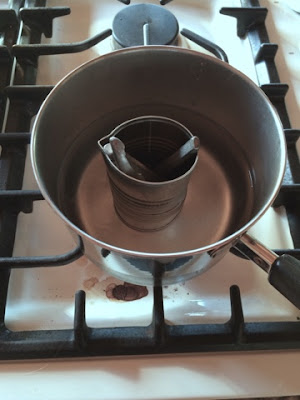Well, the time finally came up. I wedged myself into a small, wedge-shaped compartment right next to the refrigeration compressor (Turn it off! And more importantly, remember to turn it back on...).
As my body slowly became more compliant with the wedge-shaped space, I had to, slowly, with only a couple of inches freedom of movement, saw out a section of the exhaust hose.
Why just a section? Well, this stuff is about as flexible as a 3" diameter tree branch. There is no way that I would be able to bend it enough to get one end off of its pipe while the other end is connected - it's only 18" long. So I chose to cut out a section from the center, which would give me enough freedom of movement to deal with the two remaining ends.
 |
| Ugly, isn't it? |
So, over the course of a few hours, I was able to make the two necessary saw cuts thru the heavy, multiple-wire reinforced rubber. What came out, after I re-inflated my body to its normal shape, was pretty ugly.
Looking at the cut end that passed thru the external salt deposit (I cut it there on purpose), you can see that the thin outer layer of rubber is loose from the bulk of the hose. And closer examination shows that that bulk rubber at that location is actually completely cooked - hard as a rock and fractured, barely hanging together.
How did this happen? The exhaust gases are water cooled. Well, this is the top of the hose, near the water lift muffler. Nearly the worst possible location if the water flow was weak (by the time it got here, it would probably be just running along the bottom of the hose). And there have been some occasions over the years where raw water flow thru the engine was reduced. I think this is the eventual consequence, come back to haunt me a lot later.
This is the tool that I used to cut the hose. It is a handle especially designed to take Sawz-all blades. I have a metal cutting blade chucked in it for this job. It is really the only tool that I could have used to make these cuts, given the space constraints.
For the removal of the two end pieces of hose, I pressed a Dremel tool into service, using a tiny cut-off wheel. It sliced thru the rubber and the wires with ease. I had originally been worried about cutting too deep, marring the sealing surface of the pipes, but that was unnecessary. Those wires are so hard and springy that as each was severed, it opened up the cut more. It was not necessary to cut the rubber beneath the wires - their tension tore it.
Now all I have to do is bend a piece of new hose enough to get it in the space, and over the pipes at each end. Sounds easy right? A story for another time...






























